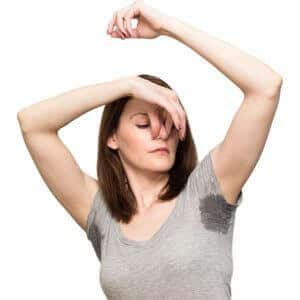
Americans are obsessed with sweat. We spend billions on antiperspirants in the quest to suppress body odor.
Nobody wants to smell nasty, but perspiration isn’t the problem. Sweat doesn’t stink. Body odor is caused by bacteria that live on the skin, breaking down the fats and proteins from sweat into aromatic acids.
Centuries ago, when it was hard to wash regularly, people tried to mask unpleasant smells with perfume. Although many underarm products contain fragrance, the primary strategy is to reduce sweating.
Are Antiperspirants the Best Solutions for Body Odor?
Antiperspirants rely mostly on aluminum salts that plug sweat glands and reduce the amount of perspiration reaching the surface of the skin. Recent research shows that this is no mere mechanical action. Instead, aluminum salts make sweat proteins clump together and stick to the walls of the sweat glands (Bretagne et al, Soft Matter, May 24, 2017). As a result, less sweat means less bacterial activity and reduced underarm odor.
What Are the Unexpected Consequences?
Less sweat also means that specialized glands in the underarm (apocrine glands) will not function normally. Kris McGrath, MD, is a Professor in Medicine-Allergy-Immunology at Northwestern University Feinberg School of Medicine. Dr. McGrath is concerned that if apocrine glands are plugged by antiperspirants, there may be unexpected consequences.
Writing in the journal Medical Hypotheses, he suggests:
“An unintentional, inadvertent, and long term hormone exposure may occur from transdermal absorption of sex hormones and pheromones (androgens) from axillary apocrine sweat gland obstruction by aluminum-based antiperspirants. The global rise in antiperspirant use parallels rises in breast and prostate cancer incidence and mortality rates.”
Dr. McGrath proposes that when apocrine sweat glands in the axilla [armpit] are obstructed, both male and female hormone levels may be altered. Few people realize that sweat glands in the underarm area even make hormones and pheromones (sex attractant chemicals). For the FDA, Dr. McGrath’s hypothesis must seem preposterous. After all, the FDA requires antiperspirants to reduce sweating in the underarm area by definition. How could the basic premise of such products be called into question?
Are Antiperspirants Safe?
Many Americans are unaware that there have been quite a few questions raised in the medical literature of late about the safety of antiperspirant ingredients. Researchers have noted that aluminum salts have estrogenic activity and that they promote the growth of breast cells (Sappino et al, Journal of Applied Toxicology, March, 2012). The authors of this study from the Division of Oncology, Faculty of Medicine, University of Geneva, Switzerland, conclude that
“Our observations do not formally identify aluminum as a breast carcinogen, but challenge the safety ascribed to its widespread use in underarm cosmetics.”
This doesn’t mean that antiperspirants cause breast cancer, but some investigators worry about a potential link (Darbre et al, Journal of Inorganic Biochemistry, Nov., 2011). We are likely years away from definitive studies proving either the safety or the danger of aluminum-based antiperspirants. However, scientists studying a mouse model (Mandriota et al, International Journal of Cancer, Dec. 15, 2016) concluded:
“Our findings demonstrate for the first time that concentrations of aluminium in the range of those measured in the human breast fully transform cultured mammary epithelial cells, thus enabling them to form tumors and metastasize in well-established mouse cancer models. Our observations provide experimental evidence that aluminium salts could be environmental breast carcinogens.”
Do aluminum antiperspirants contribute to neurological disorders? The evidence is inconclusive, but aluminum is an acknowledged neurotoxin (Maya et al, Biomedicine & Pharmacotherapy, Oct. 2016).
Do We Have Other Solutions for Body Odor?
Where does this leave the cautious consumer? Deodorants (without sweat-stopping aluminum) are one option. In addition, people have come up with many home remedies to help control body odor in part by keeping bacteria levels under control.
Rubbing alcohol is one reader’s approach:
“I use isopropyl alcohol. It’s in a little squirt-top bottle, and after showering I squirt about a teaspoonful in each hand and apply it under my arms. The alcohol is allowed to air dry a couple minutes before I dress, lest clothing absorb the alcohol before its bactericidal mission is accomplished.
“This has worked well for me over about 30 years. I had to find something because all the deodorants gave me a rash.”
A woman offers this similar solution:
“I have found that dipping a cotton ball in witch hazel [which contains 14 percent alcohol] and applying it to the underarms keeps me odor free.”
Another reader appreciates white vinegar:
“I use white vinegar in a spray bottle. I’ve had good results for over 15 years.”
Here’s another acidic solution:
“When I was growing up, my mother suggested I apply lemon juice under my arms at least once a week while I was taking a shower to avoid using deodorant.
“I rubbed my armpit with half of the lemon and left the juice on for about five minutes while I washed. Before I ended my shower, I used soap and water to remove the lemon juice. I have never needed deodorant.”
Another reader found a new use for Listerine:
“I have suffered from foul-smelling armpits as far back as I can remember. None of the deodorants I tried helped at all. As a result, I decided to try Listerine, though I was worried that I would smell before the day’s end. Instead, I was actually fresh when I got home.”
Don’t Forget MoM!
Perhaps one of the most unusual solutions for body odor is applying the laxative milk of magnesia to the underarms.
One woman reported:
“For years I have had problems with allergy to deodorants. They caused terrible underarm itching. I tried milk of magnesia and it works. Not only does it stop the odor, NO MORE ITCH!”
Luckily, you can buy house brand milk of magnesia (MoM) in any pharmacy. But how will you apply it?
People have come up with a variety of ways to get it on their underarms. Some pour a little into the palm of a hand and slosh it on. That can be a bit messy. Others soak a cotton ball and dab the magnesium hydroxide (the active ingredient in MoM) onto their underarms. One person bought a spray bottle and spritzed his underarms.
Our only concern about these approaches is the fact that the milk of magnesia laxative one purchases in pharmacies relies on sodium hypochlorite as a preservative (household bleach). Some people may prefer not to use a chlorine-based product on their underarms. That’s why we developed The People’s Pharmacy Milk of Magnesia Roll-On Deodorant.
Regardless of what home remedy you may choose to control body odor (vinegar, alcohol, witch hazel, lemon juice or milk of magnesia), we hope one of these inexpensive approaches might offer a surprisingly effective way to avoid body odor as summer heat increases underarm perspiration.
Citations
- Bretagne A et al, "The mechanism of eccrine sweat pore plugging by aluminium salts using microfluidics combined with small angle X-ray scattering." Soft Matter, May 24, 2017. DOI: 10.1039/c6sm02510b
- McGrath KG, "Apocrine sweat gland obstruction by antiperspirants allowing transdermal absorption of cutaneous generated hormones and pheromones as a link to the observed incidence rates of breast and prostate cancer in the 20th century." Medical Hypotheses, June 2009. DOI: 10.1016/j.mehy.2009.01.025
- Sappino AP et al, "Aluminium chloride promotes anchorage‐independent growth in human mammary epithelial cells." Journal of Applied Toxicology, March, 2012. https://doi.org/10.1002/jat.1793
- Darbre PD et al, "Aluminium and human breast diseases." Journal of Inorganic Biochemistry, Nov., 2011. https://doi.org/10.1016/j.jinorgbio.2011.07.017
- Mandriota SJ et al, "Aluminium chloride promotes tumorigenesis and metastasis in normal murine mammary gland epithelial cells." International Journal of Cancer, Dec. 15, 2016. DOI: 10.1002/ijc.30393
- Maya S et al, "Multifaceted effects of aluminium in neurodegenerative diseases: A review." Biomedicine & Pharmacotherapy, Oct. 2016. DOI: 10.1016/j.biopha.2016.07.035


